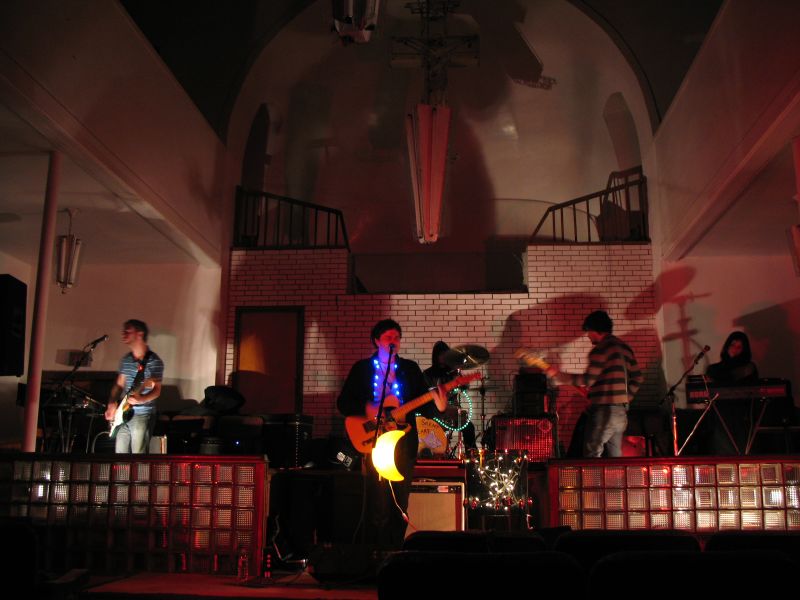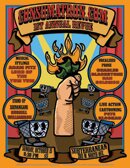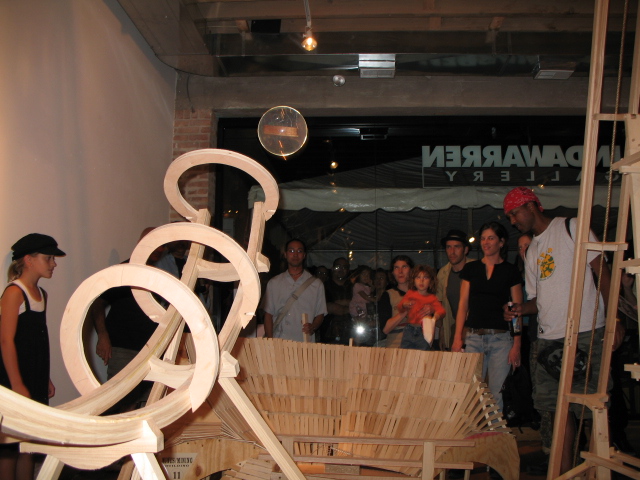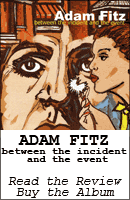Online: The Show With Ze Frank
 VLOG: The Show with Ze Frank
VLOG: The Show with Ze FrankFrequency: Daily, M-F, until 03/17/07
Location: http://www.zefrank.com/theshow/
Review: Upon first viewing, The Show with Ze Frank may seem like just some lonely guy talking into his camera and riffing on the news stories of the day. A Max Headroom for the internet age who took some speech therapy classes. On some days, that description fits perfectly. On other days, and after a few consecutive views, one can't help but get the feeling that something bigger is going on here.
Depending on the day, Ze Frank is sharp or unpolished, clean shaven or shaggy and rough around all of the edges. In fact, the only thing viewers of his week-daily video blog can be sure of is that he'll be there... For about three minutes... Putting on a show, entertaining, philosophizing, attacking the world around him with wit and (as his tagline often says) "thinking so you don't have to."
I was initially drawn to Ze Frank's vlog because I admire anyone who says they are going to do something and sticks with it. The vlog began on March 17th, 2006 and will end on March 17th, 2007. Like a New Year's resolution that came late, Frank decided to record himself talking and thinking out loud every Monday through Friday to see what would come of it. With little direction and a CNN website glowing from the computer screen behind him, March 17th's show consisted of the coffee-slugging Frank singing a makeshift theme song and using the still embryonic new media to poke fun and point out the absurdities of modern news reports on topics such as Jessica Simpson's snubbing of a Republican fundraiser.
What abruptly began as an online equivalent of trying to be the wittiest guest at a cocktail party could have just as abruptly faded into obscurity. Early on, I found myself revisiting Ze Frank's show every few weeks when I was bored at work. Nothing more. Now, I not only watch the show every day, but sometimes two or three times. Frank knows that the online mediaspace isn't just about riffing on other media. Though this schtick is still very much a part of his vlog, The Show with Ze Frank quickly evolved into something much more. As early as March 23rd, nearly half of The Show was dedicated to Frank working through a hangover and exploring his hotel room in the way a young child (or a full grown, hungover man) would. On the next day, Ze spends a little "quality time" with the viewer by smiling and staring into the camera (which he quickly acknowledges as weird).
In this world of YouTube and Myspace, the internet most certainly is a weird place, but that doesn't mean it can't be interesting and productive. Frank realizes this and isn't afraid to jump into the ball pit and play around. Sometimes, Frank finds scabs that have fallen off of the other children in the playpen, but more often than not, Frank seems to find lost change, dollar bills and other treasures. Most importantly, Frank doesn't discount the other kids (or as he refers to them... duckies, or Sports Racers) in the pond.
Interaction is key when using the internet as your primary medium. It's how the internet began and it's where the full circle of technology has brought us. Frank didn't wait long before integrating his viewers' comments into his daily show, sometimes sculpting whole episodes around someone else's thoughts. Though Frank says he is "thinking so you don't have to," his viewers do think, comment and influence the direction of the show more than anyone could have expected. It is Frank's ability to accept and encourage this interaction that has made him a success.
No "newbie" to the net, Frank's personal website (zefrank.com) became popular in 2001 when he sent out an animated invitation for his 29th birthday party to seventeen of his closest friends. The interactive invitation featured Frank demonstrating ten ridiculous dances. It was forwarded to several of the friends' friends and picked up a momentum that netted Frank's site over 100 gigabytes of daily web traffic. The E-mails began pouring in from across the globe and Frank began using his free time to create contests and simple Flash tools and games for the people who contacted him. (All of these projects are archived and can be seen on zefrank.com). His fan base grew and "just another guy" had become an online personality. Time Magazine featured zefrank.com as one of the 50 coolest websites of 2005 and he was a featured speaker at the TED (Technology Entertainment Design) conference in 2004-05.
Frank's fine mix of humor and sincerity can sometimes be hard to separate (as can be seen in the audience response during Frank's 2004 TED speech), but The Show has managed to let him explore both method and reaction. Like a grand social experiment, The Show has gone through many phases, adjustments and changes. Most importantly, The Show remains an open forum for Frank and his viewers in which they can explore the meaning and purpose of this bourgeoning online space that is becoming so much more integrated with our daily lives.
The spirit of exploration and collaboration quickly became a recurring theme in The Show, stretching much farther than the viewer's comments. On the May 16th episode, Frank issued a bizarre and humorous challenge to his viewership of "Sports Racers." The challenge was to place two pieces of bread on the ground simultaneously at points directly opposite each other on the globe. Doing this, would create the world's first "Earth Sandwich." Viewers sent in pictures of themselves placing bread on the ground along with their geographic coordinates and the hunt was on. In less than a month, two brothers succeeded in completing this absurdist mission by placing a baguette on the ground in Spain, opposite of another viewer's baguette in New Zealand.
From this point on, the collaborative spirit seemed to avalanche. Frank continued to encourage interaction on all levels by asking viewers to send in their own videotaped introductions for the show, playing a game of chess with the viewers through a wiki page, and urging viewers to remix a stray audio clip of a man named Ray singing a song for his daughter into a full song and music video (which will be delivered to Ray upon completion).
As the community of "Sports Racers" grows, projects have begun taking on a life of their own. One of the most recent projects surrounding The Show began, simply enough, when a forum member known as RunningFool asked if someone could provide him with a ride home for the holidays. Instead of a simple trip from Eugene, Oregon to southern California, other members of The Show's forum suggested that he try travelling across the country and back, using only forum members for lodging and travel. Liking the idea, Frank announced it on his show and over 350 people from across the U.S. volunteered to help. The project spawned another site (HumanBaton.com) to chronicle RunningFool's travels. Known in the real world as Luke Vaughn, the RunningFool has traveled over 9,000 miles in under a month. Luke has this to say about the project:
"I think the internet is a hugely positive thing, and that people don’t give it enough credit, and this is going to be something that maybe people will look at and say that’s really cool, and that the community isn’t just a bunch of people being fake. That there’s actual people behind the computer screens who are interacting, and who share important things with each other."It is also with that attitude, that Ze Frank continues to make 3-5 minute shows on his site each weekday. With each show's tone ranging from humorous, angry, serious, silly and, sometimes, deeply sentimental, Frank has not forgotten that there are actual people behind the computer screens. People who have a desire to interact, share, create and learn things from one another. Yes, he does attempt to make money from his performances and for a few more months, Ze Frank will be performing for us... Providing entertainment, snarky commentary, irreverent humor and his own unique way of looking at the world.
Most importantly, however, is Frank's willingness to communicate with people and encourage his viewers to do the same. Frank's celebrity could be a flash in the pan, but I think he realizes this and embraces the creativity of the everyday people out there. He's even started an online community space for his fans which focuses on showcasing the creative output of its members.
New media couldn't ask for a better star... Fortunately for those of us who aren't struck mute by stars, Ze Frank has the foresight and humility to ask us all to shine.
Rating: 4.5 / 5
The Show with Ze Frank: Link
ZeFrank.com: Link
Ze Frank's 2004 TED appearance: Link














































